Before I start this evening, I want to offer corrections to my last piece on REITs.? Sorry, data glitch, and the results are a little different but the conclusions are unchanged.
Here is the correct regression for Mortgage REITs:
And the the correct regression for equity REITs:
Why the change?? The main difficulty was that the first set of regressions was disaligned time-wise because the twenty-year Treasury yield was not estimated by the Fed for about ten years.? This calculation adjusts for that.? Interesting that when you use the correct data, mortgage REITs fit less well.? That’s an odd happenstance.? Equity REITs, are around the same — though the t-statistics look worse because I included two more points on the curve.
But now to the point of tonight’s piece.? After my last piece, one reader said:
This sounds like an interesting scenario to use your grid analysis, where your quantiles might be ranked using (1) equity/mortgage REIT spreads and (2) monetary policy (measured by either short term rates or yield curve slope).
I decided to try it, except for one thing.? I thought that using the spreads or yields in quintiles would have too much information about the future that if an investor knew the limits of how high or low yields could go, it would be too simple.? The surprise was this: I tried it for fun, and it was no better than what I will show you.
I chose two variables:
- Yield curve slope, measured by twenty-year yield less one-year yield
- Momentum, measured by amount the price is over the ten-month moving average.
I divided both up by quintiles, reasoning that an investor focused on momentum and the yield curve would have enough data from history prior to 1972 to generalize what would be favorable and unfavorable conditions for investment.
Here is what I found for Mortgage REITs:
and what I found for Equity REITs:
Both data series? confirmed one idea.? Momentum matters.? (Now the yield curve matters, but not so much.)? So I constructed a rule to be invested in REITs if they were in the third momentum quintile or higher, or be invested in one year Treasuries otherwise.
So what were the results?? Equity REITs:
The difference in returns is 20.8%/year following the strategy versus 12.0% not following the strategy.
Now what for Mortgage REITs, that properly despised subindustry group?
The difference in returns is 22.4%/year following the strategy versus 5.1% not following the strategy.
The bizarre result is that though equity REITs trounced mortgage REITs? over 38+ years as indexes, the momentum strategy makes mortgage REITs do better then equity REITs.? That is probably because the returns on mortgage REITs are more autocorrelated — they streak more.
I just say wow, and wonder at it all.? I have some daily models for interest-rate sensitive sectors that I haven’t trotted out yet, which switch between mean reversion and mean aversion that do better than this, but I don’t believe them because they are too good.? It is possible to trip onto something parsimonious that explains history if you are smart enough.? I prefer stuff where I have a theory behind it, as with momentum, where people are slow to catch on.
Now, after all of this, I will tell you I have no money riding on this.? None. Nada. Null.?? Part of this is that it would not be so good when implemented in real-time, and mortgage REITs are a thin industry.? More of it comes from an aversion to what might happen if/when momentum investing becomes pervasive.? We had a taste of that in Summer 2007, where momentum strategies blew up for a short time.? For those willing to see it through, though, it did not amount to much.
So long as? momentum is an incidental strategy to the market, it can work well.? It can never be the main strategy of the market lest matters go totally nuts.

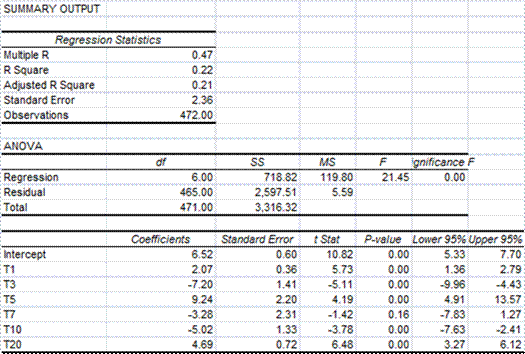
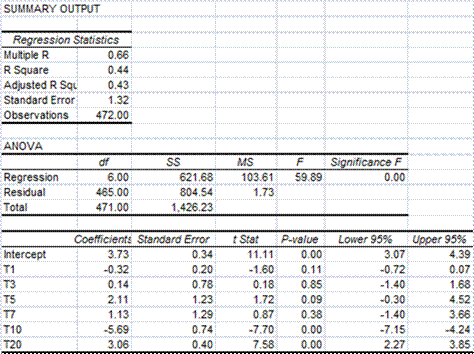
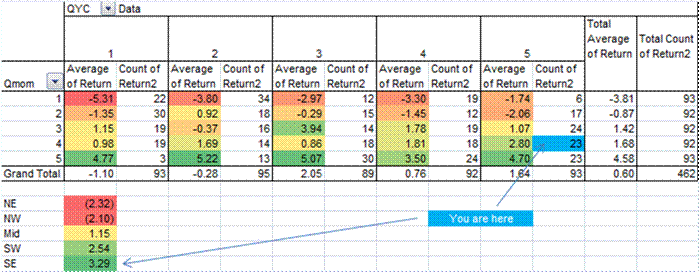
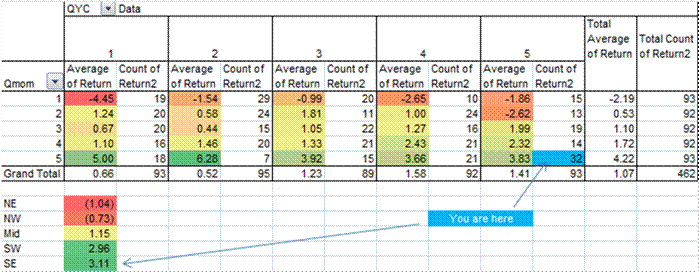
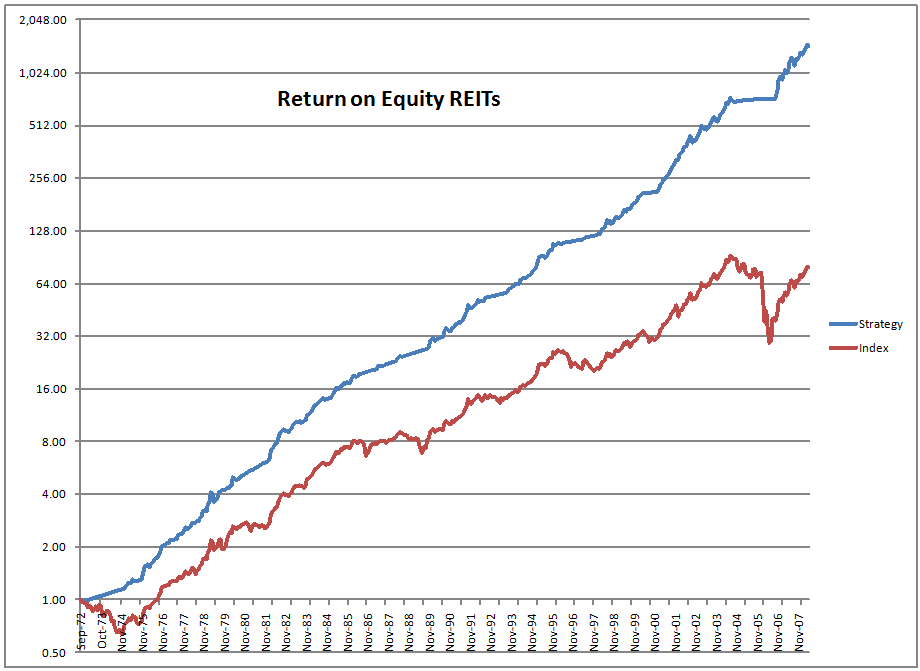
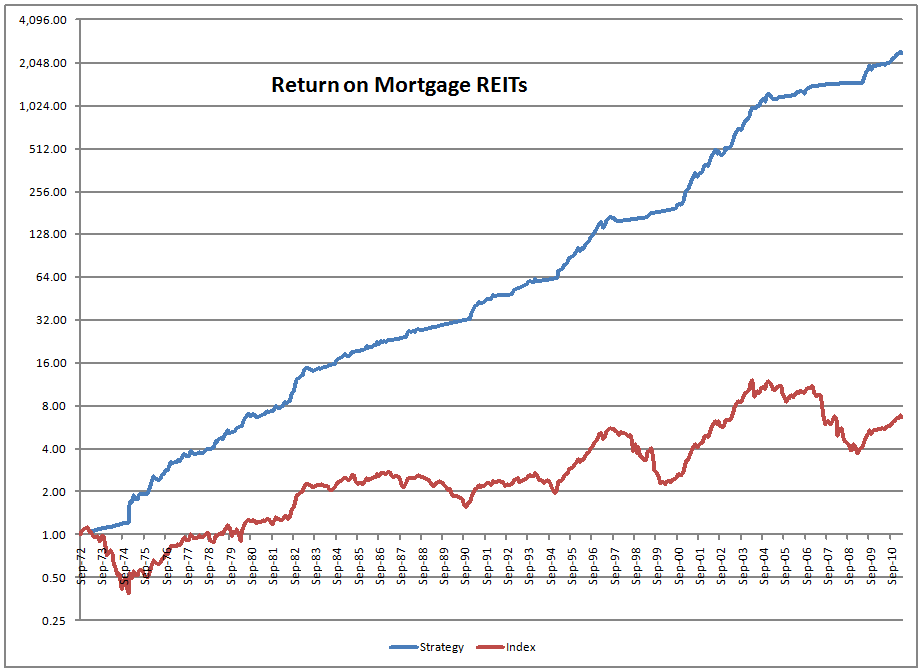
Hi David,
Thanks for the analysis. I am looking to do this type of statistical analysis. Am just starting towards my MBA while working full time in the asset management business. What books do you recommend to help with the process? I am pretty decent, but need to seriously polish my skills to know when the analysis I do is valid, versus just throwing some numbers together and data mining to create a strategy that is largely guaranteed to lose money.
Thanks.
Good stuff, David…as always. Here’s the thing with momentum. I don’t believe it will EVER (or maybe CAN ever) be the main strategy of the market. Why? The market as a whole is driven by the largest institutional players. It really isn’t possible to manage 10s of billions of dollars (let alone much more) in a relatively simple and straightforward momentum approach. So long as managers have a desire to grow assets to very large levels (in other words, so long as human being still act as human beings on average!), other forms of investing will still dominate momentum from an AUM standpoint. Whether it is valuation-driven, quality-driven, or even a mean-reversion stat arb approach, other forms will take the overall lead. There will always be little blips every now and then and individual stocks or sectors that become momentum-driven for a time, but on average, I don’t think that will ever persist on a broad scale.
That’s why I believe momentum or trend following (no, they aren’t the same, but I’ll lump them together for the time being), when used in a disciplined format that is based on logic and not just a data-mining exercise, is a tremendous approach for individuals and small asset managers. This is a yet another reason why small fries have an advantage over the big guys on average.
ljoneill, when momentum gets to be over 20% of the market as a strategy, things go nuts, as in August 2007. Momentum will always be a lesser used strategy.
dkenny, most of the books that I recommend are listed in my categorized book reviews section. They are ranked from best to worst, so have a look.
David,
Your comment about August 2007 intrigues me. Following the fund industry as carefully as I do and factor returns as carefully as I do, I’ve never attributed the mayhem of August 2007 to momentum…or even heard others primarily attribute it to that. There were four or five days where quant strategies went absolutely haywire, underperforming benchmarks by several hundred basis points in less than a week, but that was more of a crowded traded phenomenon coupled with the unwinding of some huge quant hedge funds (Goldman’s Alpha fund primarily, as I recall). Obviously, momentum is a key factor in those sorts of quant strategies, but I don’t consider quants and momentum to be anywhere close to synonymous. So I don’t think of August 2007 as a momentum issue. Am curious if you have other research or data that would show the opposite.
Luke, when I was gathering data for a talk that I was giving to the Denver CFA society, I went to a number of news sites to go over August 2007, as well as reviewed what I wrote at the time.
http://alephblog.com/2007/08/
Quant funds had been progressively levering up more, because unlevered performance had been waning 2000-2007. What some hypothesize is that a large fund began reducing leverage for risk control purposes, leading to a self-reinforcing rout/rally in the types of stocks that the quant funds tended to buy/sell.
Look at page 7 of my presentation:
http://alephblog.com/2010/11/12/notes/
Some of the links there might help.
Very fine piece of work. I would love your comments and approval on http://timelyportfolio.blogspot.com/2011/06/reits-for-everybody-might-now-mean.html where I replicate the momentum strategy in R